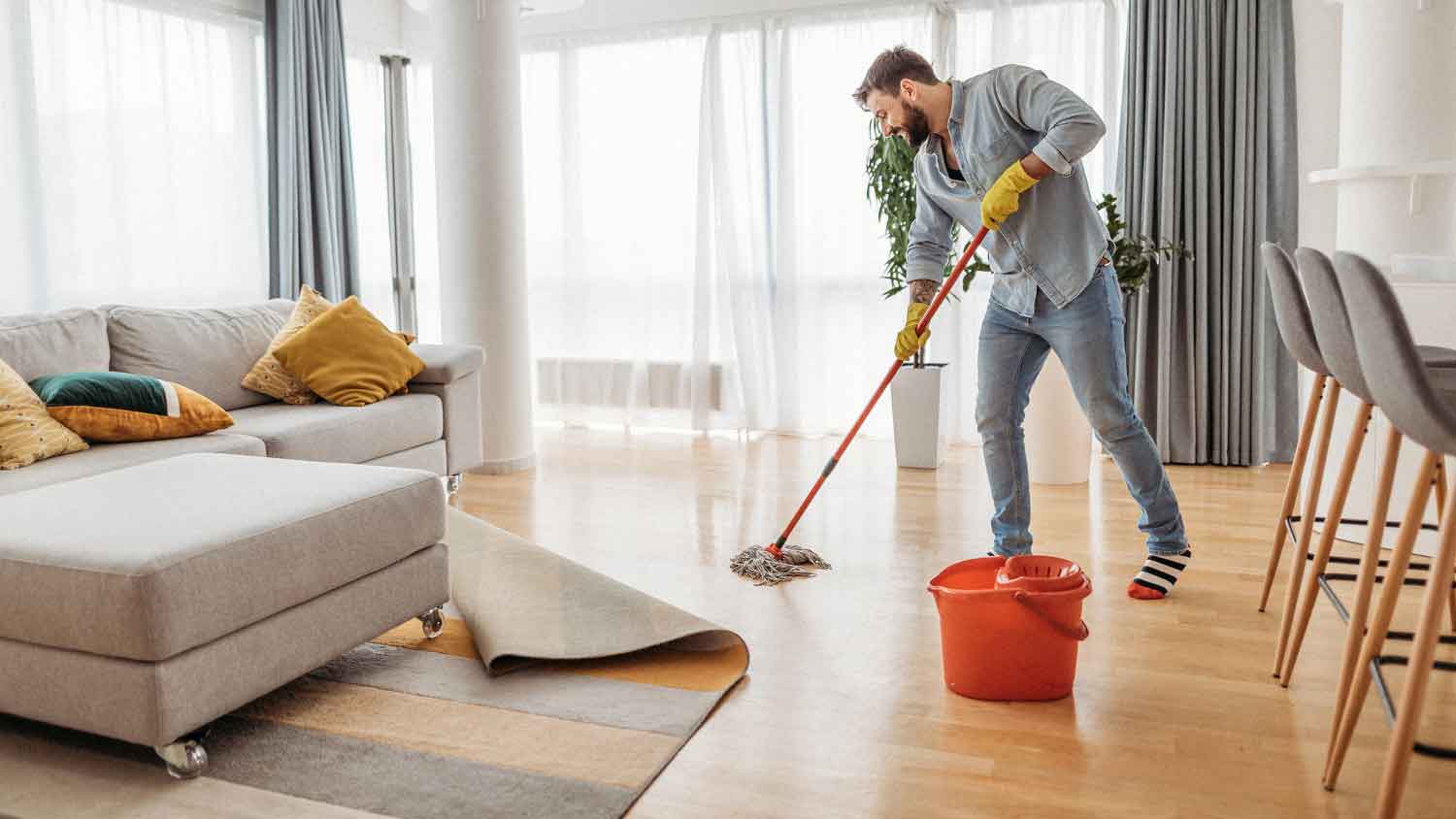How to Organize Kitchen Cabinets and Keep Them Clean and Tidy
Say goodbye to digging through your cabinets for your favorite mug


Have you ever been in the frustrating situation of putting dinner leftovers away, only to have a pile of mismatching containers and lids spill out when you open the kitchen cabinet? Aside from looking cluttered, messy kitchen cabinets can also make simple tasks, like cooking, take longer while you search for what you need.
Take control over your kitchen cabinet organization and follow these guidelines for a more streamlined system. Here’s how to organize your cluttered kitchen cabinets, plus tips for keeping them tidy.
Why Should I Organize My Kitchen Cabinets?

How much time do you spend looking for the lid to your travel mug or pulling the blender out of the back of the cabinet? Cluttered cabinets can cause you to spend extra time looking for specific items or misplace things stuck in the back of the cupboard. Plus, you may waste money buying duplicate items because disorganized kitchen cabinets make it difficult to keep track of what you own.
That’s why it’s essential to organize your kitchen for maximum efficiency, starting with the cabinets. You’ll save time on everyday tasks like cooking and cleaning, plus you’ll feel less stressed once you can easily locate every kitchen item and appliance.
How to Prep to Organize Kitchen Cabinets
Before you bust out the label maker, you’ll want to prepare to organize. Follow these preparation steps to get ready to declutter and set the stage for organization.
Declutter
Start fresh by getting rid of knick-knacks and dinnerware you don’t use or like anymore. Take everything out of the cabinets, and sort into items you want to keep and items to sell, donate, recycle, or toss.
Plan Out Zones
Once you take stock of your inventory, start mapping out zones. This tactic involves grouping similar items together and placing them in an ideal spot based on their use frequency. For instance, you can dedicate one shelf near the stove for spices and seasonings. Group bakeware together and place in a reachable cabinet, and consider keeping cutting boards, citrus juicers, and other food prep tools in the cabinet near where you like to prep food.
Purchase Organizing Tools
You may want to buy organizing bins, shelves, hooks, turntables, and other tools to help declutter your cabinets. To avoid buying brand-new items, consider upcycling items like glass jars to store snacks or other dried goods in your food cabinets.
How to Organize Kitchen Cabinets

Now that you have a game plan, it’s time to get organized. Start wherever makes the most sense for you, then move from cabinet to cabinet installing your organizers and replacing your household items.
Install Shelves or Risers
Your cabinets may have no shelves or shelves that are very far apart, leaving a lot of unused vertical space. To maximize your storage space, add risers or standalone shelves for stacking items and creating more space in your cabinets.
Consider Shelf Sliders
Shelf sliders can be a convenient way to keep your cabinets organized. These devices install into your cabinet bases. Then, you place items on top, and you can grab the end of the slider and pull the whole thing outward. Shelf sliders are also a great idea for organizing your kitchen pantry. That means no more lost container lids or kitchen gadgets falling to the back of the cabinet, never to be seen again.
Add Turntables
Turntables, also known as lazy Susans, are ideal for items you use often, since you can spin this organizer around to grab what you need. Use these organization tools for spices and seasonings, cooking oils, vinegars, sauce, or other items you are always grabbing. You can also add a turntable inside your refrigerator to keep it organized.
Insert Bins and Baskets
Bins and baskets are a smart way to group individual containers of similar items. Chips can go in one bin, while granola bars can sit in another. You can group your impressive hot sauce collection together in one basket or keep all your canned goods together in one spot.
Move Dry Food to Airtight Containers
The food we buy comes in many different containers, making it difficult to fit things neatly into a cabinet. For dried goods, like pastas, flour, sugar, or nuts, use a set of airtight containers that stack to make the most of the space. Use an extra basket to store any surplus food left in its original package that doesn’t fit into the airtight container.
Place Cleaners in Caddies
Kitchen cabinets aren’t only for plates and cups. The cabinet under the sink is probably home to most of your cleaning supplies, and this area can get cluttered, too.
Group similar items together, such as multipurpose cleaners in one section and floor cleaners in another. Organize groups of cleaning supplies into caddies, which are easy to pick up and take with you from room to room. For cleaners that you use less frequently, sort them into separate bins.
Label Items
Before putting organizing tools in their final spot, use a label maker or label stickers and a permanent marker to label the bins, baskets, and other storage containers with their contents. That way, you’ll be able to keep track of each item’s location.
How to Keep Cabinets Organized

Getting the cabinets organized is only half the battle. The real challenge is sticking to your organization system to keep the clutter from piling up again. Follow these guidelines to maintain an organized kitchen cabinet system.
Put Items Back Where They Belong
It’s easier said than done, but you should take a few extra seconds to put an item back in its (labeled) spot after each use. That might mean collecting spices after making dinner and moving them back to their tiered racks in a cabinet. It could look like pairing clean food storage containers with their lids while unloading the dishwasher rather than putting those items away one at a time.
Ensure everyone in your household knows to put things back where they found them. If you don’t have time right away to do so, take a few minutes at the end of the day to pick up items around the kitchen and put them away.
Declutter Regularly
It’s easy to let unitaskers (like avocado slicers or strawberry coring tools) pile up in the cabinets. But if that product didn’t change your cooking skills like you thought it would, it’d be better off going to a new home than taking over your cabinet.
Plan to go through the kitchen cabinets once a month to remove expired foods and every six months to sort through kitchen tools and small appliances. That way, you can prevent a messy build-up of rarely used items and appliances.
Maintain Clean Cabinets
It’s equally important to keep your kitchen cabinets clean as it is to maintain their organization. Clean your kitchen cabinets based on its material, using different methods for wood and laminate. You can also install cabinet liners to prevent staining or damaging the interior finish.
DIY vs. Hire a Pro
If you want to organize the cabinets, the biggest cost is your time. It may take a few hours to clear out the cabinets, separate the items you don’t want, create an organizing system, and implement it. You may also spend $100 or more on organizing bins, baskets, shelves, and other organizing supplies.
Hiring a professional organizer costs about $55 to $100 per hour, or an average of $480 per project. If you don’t have the time to organize the cabinets yourself, hiring a pro can help get your kitchen organization on track. Professional organizers will also work with you to create a system to keep those cabinets organized.
FAQs
Check out these answers to common questions about kitchen organization.
What should not be stored in kitchen cabinets?
Of course, you’ll want to stow away dinner plates and water glasses in your kitchen cabinets, but you should store items that you barely use and items that you constantly use elsewhere.
Keep small appliances stored away in a closet or pantry. Keep items you frequently use, like the coffee maker, on the counter, or on a bar cart, so you aren’t constantly pulling items out and putting them away.
How can I maximize space in my kitchen cabinets?
Kitchen cabinets are great for hiding away your plates and glasses, but there always seems to be excess vertical space that you don’t use. If you have adjustable shelves, move them around, placing tall items on one shelf together and short items on a different shelf together.
No adjustable shelves? No problem. Use shelf risers instead to fit smaller items, like ramekins, on the top shelf over your bowls or mugs or for organizing spices and seasonings.














